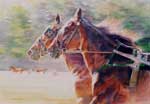In Chicago in 1923, four men met to work out the details of a proposed rich race for 3-year-old trotters. They
had examined every aspect of how they could make this stake into the biggest in the sport, a race that would attract national
attention, and would serve as a “proving ground” for the best horses in America.
 |
| The original Hambletonian trophy was presented to David M. Look (left) in 1928, for Spencer. |
John Bauer, publisher of The Horse Review, and two of his writers, Joe Markey and John Hervey, were talking
with racing promoter Harry Reno. When seemingly all the details were resolved, Bauer tilted back in his office chair and posed
a question. “Well, boys, what do you propose to call this race?”
The others were shocked. Every aspect of the race had been discussed except a name. It needed a name,
and a name worthy of the status these men hoped it would achieve.
Several names were suggested, but quickly discarded. Hanging above Bauer’s desk was a portrait
of the great stallion Hambletonian by artist Robert Dickey, and that served as an inspiration for Bauer.
“I propose we call in the Hambletonian Stake,” Bauer said. “The trotting breeding
today is a Hambleotnian breed. There is no other name in the trotting world that means so much.”
Bauer was right. The coarse bay stallion Hambletonian had come into the world in 1849 when there really
was no fixed trotting breed----just a patchwork quilt of horses which showed some ability to trot. When the offspring of Hambletonian
began to race in the 1850s and 60s, the rival male lines were soon swept into oblivion. They simply could not compete in trotting
contests with the descendents of Hambletonian, who spent his entire life in Orange County in New York State, about an hour’s
drive from New York City..
Ironically, Hambletonian himself never raced although he was exhibited on the trot and showed speed
and gait. Physically, he was a large, raw-boned horse with a head that only a mother could love. But horse racing has never
been a beauty contest. The success of his offspring increased the demand for his breeding services and he ultimately sired
more than 1,000 foals.
Of the many sons sired by Hambletonian, four emerged above all others to shape the future of the American
trotter---Dictator, Electioneer, George Wilkes, and Happy Medium. As the blood of these horses began to be mixed on both the
male and female side of pedigrees, the progress in trotting speed was nothing short of amazing.
By 1900, the Hambletonian line dominated trotting with only a few vestiges of the other male lines.
These rival lines were ultimately extinguished by the superiority of the Hambletonian tribe. Today every American-bred harness
horse traces in his male line to Hambletonian.
When John Bauer proposed to name the new race after the “founding father” of American trotter,
he selected the perfect name and the Hambletonian became the greatest American trotting race soon after it was first raced
in 1926.

